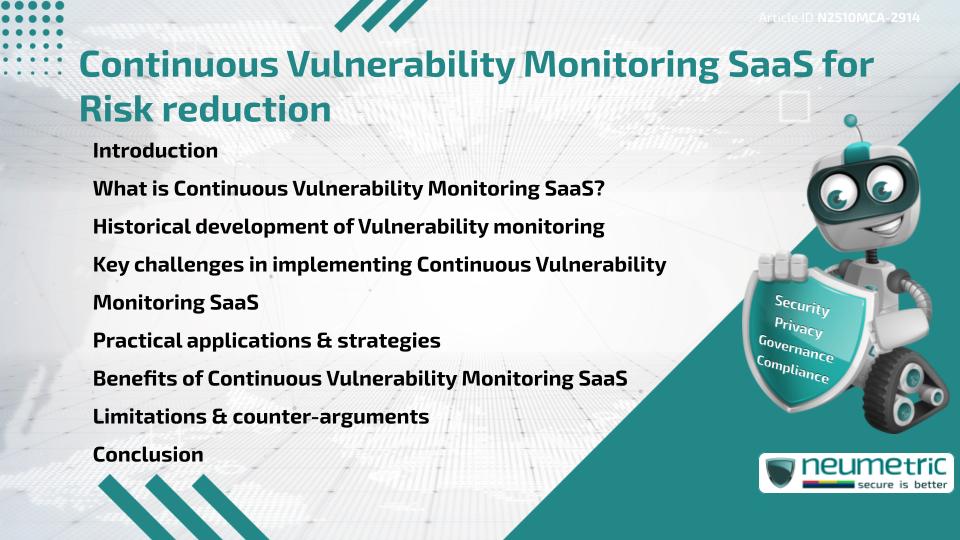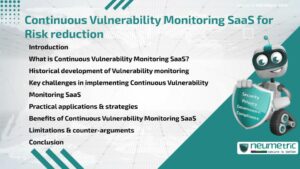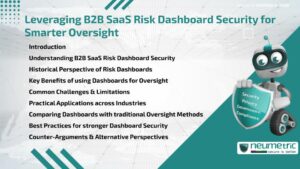Table of Contents
ToggleIntroduction
Continuous Vulnerability Monitoring SaaS plays a central role in modern Cybersecurity Strategies. By offering real-time oversight of system weaknesses, it helps Organisations identify & fix potential Risks before attackers can exploit them. As Cyber Threats grow in complexity, this proactive approach is vital for reducing exposure, ensuring compliance & maintaining Client trust. This article explores its origins, challenges, strategies for implementation, benefits & the reasons why businesses cannot afford to overlook this practice.
What is Continuous Vulnerability Monitoring SaaS?
Continuous Vulnerability Monitoring SaaS refers to cloud-based platforms that provide ongoing detection of software & network Vulnerabilities. Unlike traditional scanning performed at set intervals, Continuous Monitoring offers real-time insight into emerging Risks. These tools alert teams when a Vulnerability is identified, making it possible to patch systems quickly. This approach enhances visibility & creates a stronger security posture for businesses of all sizes.
Historical development of Vulnerability monitoring
The practice of Vulnerability monitoring began with periodic security audits & manual checks in the early days of IT. As networks grew more complex, automated scanners emerged in the late 1990s & early 2000s. These tools, however, often left gaps between scans, allowing attackers opportunities to exploit weaknesses. The introduction of Continuous Vulnerability Monitoring SaaS closed this gap by automating detection & reporting on a 24/7 basis. It reflects a broader trend toward real-time Cybersecurity solutions.
Key challenges in implementing Continuous Vulnerability Monitoring SaaS
Adopting this solution is not without challenges. One obstacle is managing the large volume of alerts that Monitoring Tools may generate, which can overwhelm teams. Another challenge is integrating these systems with existing IT infrastructure, which may involve compatibility issues. There are also concerns about costs for small & medium businesses, especially when advanced features like machine learning are included. Finally, Organisations must ensure staff are trained to respond effectively to findings.
Practical applications & strategies
Businesses can maximize the value of Continuous Vulnerability Monitoring SaaS by combining it with strong Patch Management Policies. Regular training for IT staff ensures they can interpret alerts accurately & respond promptly. Integrating Monitoring Tools with Security Information & Event Management [SIEM] systems can also provide a more comprehensive view of Threats. Additionally, prioritizing Vulnerabilities based on severity helps teams focus on the most pressing Risks without wasting resources.
Benefits of Continuous Vulnerability Monitoring SaaS
The primary benefit is Risk reduction. By addressing Vulnerabilities as they arise, Organisations can significantly reduce their attack surface. Continuous Monitoring also helps businesses stay compliant with regulations such as GDPR & HIPAA, which require proactive Security Measures. Furthermore, it enhances Transparency & Accountability, allowing businesses to demonstrate security diligence to Clients & Partners. The combination of improved security, compliance & trust makes this practice highly valuable.
Limitations & counter-arguments
Critics argue that Continuous Vulnerability Monitoring SaaS can create a false sense of security if not paired with proper response protocols. Simply identifying Vulnerabilities is not enough-timely remediation is essential. Smaller businesses may also view it as costly or resource-intensive. Moreover, no monitoring solution is perfect & sophisticated attackers may still find ways to bypass defenses. These limitations highlight the need for a balanced approach that integrates monitoring into a broader Cybersecurity Framework.
Conclusion
Continuous Vulnerability Monitoring SaaS is a powerful tool for reducing Risks in modern business environments. While challenges & limitations exist, the benefits of real-time detection, compliance support & improved trust outweigh the costs. By implementing these systems strategically, businesses can stay one step ahead of Cyber Threats.
Takeaways
- Continuous Vulnerability Monitoring SaaS detects Risks in real time & strengthens defenses.
- The evolution from periodic scanning to Continuous Monitoring reflects the need for proactive security.
- Implementation challenges include alert fatigue, integration issues & costs.
- Best Practices involve combining monitoring with Patch Management, training & SIEM integration.
- Benefits include compliance, Risk reduction & stronger Client trust.
FAQ
What is Continuous Vulnerability Monitoring SaaS?
It is a cloud-based platform that continuously scans & detects system Vulnerabilities to reduce Risks & support secure operations.
How does it differ from traditional Vulnerability scanning?
Unlike scheduled scans, Continuous Monitoring provides real-time alerts, reducing the gap between Vulnerability detection & remediation.
What are the benefits of Continuous Monitoring?
Benefits include Risk reduction, Regulatory Compliance, operational resilience & stronger Client confidence.
Is Continuous Vulnerability Monitoring SaaS expensive?
Costs vary, but even smaller businesses can adopt scalable solutions. The investment often saves money by preventing costly breaches.
Does Continuous Monitoring eliminate cyber Risks?
No system eliminates Risks completely, but Continuous Monitoring significantly reduces the chances of exploitation by attackers.
How can businesses manage alert fatigue?
By prioritizing Vulnerabilities based on severity & integrating monitoring with SIEM systems, teams can avoid being overwhelmed by alerts.
What industries benefit most from this solution?
Industries handling Sensitive Data, such as Finance, Healthcare & Government, benefit greatly due to regulatory demands & high-Risk exposure.
References
Need help for Security, Privacy, Governance & VAPT?
Neumetric provides organisations the necessary help to achieve their Cybersecurity, Compliance, Governance, Privacy, Certifications & Pentesting needs.
Organisations & Businesses, specifically those which provide SaaS & AI Solutions in the Fintech, BFSI & other regulated sectors, usually need a Cybersecurity Partner for meeting & maintaining the ongoing Security & Privacy needs & requirements of their Enterprise Clients & Privacy conscious Customers.
SOC 2, ISO 27001, ISO 42001, NIST, HIPAA, HECVAT, EU GDPR are some of the Frameworks that are served by Fusion – a SaaS, multimodular, multitenant, centralised, automated, Cybersecurity & Compliance Management system.
Neumetric also provides Expert Services for technical security which covers VAPT for Web Applications, APIs, iOS & Android Mobile Apps, Security Testing for AWS & other Cloud Environments & Cloud Infrastructure & other similar scopes.
Reach out to us by Email or filling out the Contact Form…





